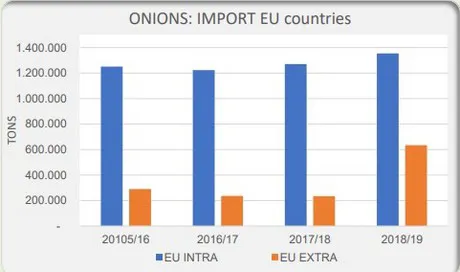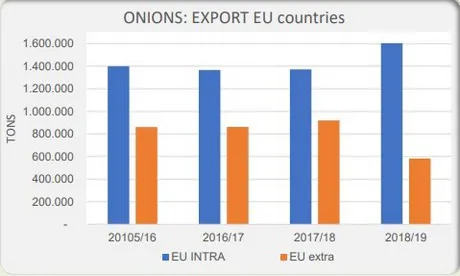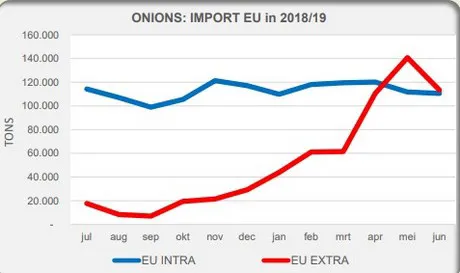In the 2018/19 season, onion exports from EU countries to countries outside the Community were about 300,000 tonnes down on the previous three seasons.
Imports from non-EU countries, on the other hand, was 400,000 tonnes larger. In the past season, there were 700,000 tonnes of extra onions available for the EU market compared to previous seasons. That amount had to fill the gap caused by the small EU harvest due to the drought in large parts of the EU. In the Netherlands alone, the onion harvest in the last season, at 810,000 tons, was around 600,000 tons smaller than the average in the previous three seasons.
Based on Eurostat (CBS) figures, the export of onions excluding (1st year) planting onion sets and shallots from the Netherlands in 2018/19 amounted to more than 1.3 million. That was 'only' 100,000 tons less than the average in the previous three seasons. That was the sum of 275,000 tonnes less exports to countries outside the EU and 160,000 tonnes more exports to EU countries. The share of countries outside the EU in 2018/19 was less than 40% against 55% on average in the three previous seasons.
Only the Netherlands exports larger quantities to countries outside the EU
Outside the Netherlands, few onions are exported by other EU countries to countries outside the EU. In the past season, the other EU countries exported more than 60,000 tonnes to countries
outside the EU of which 35,000 tons from Spain. In the past season, EU countries traded around 1.5 million tonnes, half of which through the Netherlands. In addition to the enormous amount of onions that the Netherlands exports, import is also important.
In the last season the Netherlands imported 365,000 tons. This has grown considerably in the last three seasons, from 170,000 tonnes in 2015/16 via 210,000 tonnes in 2016/17 to 240,000 tonnes in 2017/18.


Imports to the Netherlands: A lot of Egyptian onions, but also many more from various other countries
More than half of Dutch onion imports came from (via) EU countries in the past season, namely 200,000 tons against 165,000 tons from non-EU countries. Egypt was the most important supplier with 85,000 tons in 2018/19. The three seasons before were always around 35,000 tons. The Netherlands also imported (many) more onions from various other countries. This included Spain, New Zealand, Belgium, China, France, the United States, the United Kingdom, Morocco, Austria, India, South Africa and Australia.

More imports from Kazakhstan, Peru, Turkey, Uzbekistan and Chile in other EU countries
215,000 tonnes were imported from Egypt throughout the EU last season. In addition to the Netherlands, significant quantities of Egyptian product also went to the United Kingdom (50,000 tonnes) and Italy (25,000 tonnes). Other non-EU countries from which onions came to the Community were New Zealand (100,000 tonnes), India (43,000 tonnes), Kazakhstan (42,000), Peru (34,000), China (30,000), Turkey (24,000), Uzbekistan (21,500 ) and Chile (20,000 tonnes). The centre of gravity for imports from non-EU countries fell in the second half of the season, particularly in the months of April, May and June.
According to the KCB, more than 23,000 tons of foreign onions were exported in the 2018/19 season. The KCB also registered an export of Dutch onions of 823,000 tonnes. Together with the re-export, this amounts to 845,000 tons. According to CBS and Eurostat, that was much more, namely 1.3 million tonnes. There was also a large gap between KCB and CBS / Eurostat figures last season. The difference is entirely due to exports to EU countries. CBS / Eurostat, in particular for EU countries, provide a considerably larger export than KCB. In the past season, that gap was 470,000 tons, namely 1,317,000 tons against 846,000 tons (823,000 tons of Dutch product and 23,000 tons of re-export).
View the entire factsheet here.
Source: Jan Kees Boon
Fruit and Vegetable Facts
www.fruitandvegetablefacts.com
fruitvegfacts@gmail.com
